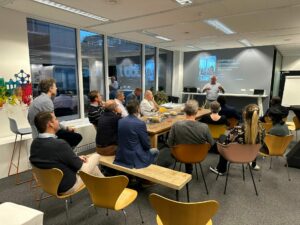Enterprise architects work at the intersection of business and IT, often finding themselves translating complex technical systems into language that business leaders can understand. The key to their success is effective communication, but many struggle to convey the importance of their work to stakeholders who may be focused on budgets, timelines, or business outcomes.
Speaking Two Languages, Welcome to Belgium
At last week’s Tribe Connect, seasoned architect Luc Alix highlighted that architects often face significant roadblocks, such as failing to secure budget approvals and the preference for short-term tactical decisions over long-term strategy. These issues often stem from communication gaps. Business leaders, focused on immediate financial and operational concerns, may not fully grasp the strategic value of the architect's vision, which can result in budget denials or suboptimal tactical decisions.
Architects need to bridge these two worlds - technical and business - by finding a common ground. This can be particularly difficult because while architects may be skilled at discussing applications and infrastructure, they may lack the language or context to effectively communicate broader business implications.

The Power and Pitfalls of Visual Communication
One of the most effective ways for architects to overcome communication barriers is through visual presentations. Our keynote speaker underscored that visual communication has a unique ability to make complex concepts more accessible, stating that a visual message is stronger and sticks longer compared to a written or verbal message. “I have just earned my diving instructor license. Architects are like divers: we need a common and in the case of divers even voiceless language to understand each other.”
Diagrams, charts, and visual representations of architectural plans can help non-technical audiences grasp intricate IT landscapes more easily, offering a way to break down technical jargon into digestible information.
However, visual communication is not foolproof. Luc Alix also warned that visuals, when not backed by robust, verifiable data, can lead to misinterpretation or mistrust. Diagrams that are created without a deep data foundation may oversimplify the reality or omit key details, weakening the architect’s credibility.
Effective visual communication requires architects to continually update their repositories with real-time data and ensure their visuals reflect the most accurate and comprehensive information available. “Although older dataflow repositories in for instance Visio are difficult to work with”, said a Tribe Connect participant. “Today they are more data-driven, searchable and you see the dependencies and the impact of architectural decisions.”
This balance between simplicity and accuracy is critical. While visuals can enhance clarity, they must be constructed from data-driven insights to maintain trust and foster productive conversations.
Building an architecture repository using a common language with ArchiMate
Another way architects can improve communication is by adopting ArchiMate, a standardized modeling language designed to describe enterprise architecture. ArchiMate provides a shared meta language, helping architects communicate effectively across different teams, from IT professionals to business stakeholders.
This common language reduces the risk of misinterpretation, as all parties use the same definitions and structures when discussing the architecture. “But”, Luc Alix warns, “do not look at it as a mere framework, the value of ArchiMate lies in your repository. Building a diagram does not tell a story, the truth and value lies in your non-deniable facts.”
Enterprise Architect Alain Garsoux emphasized the importance of not only using ArchiMate but also building it on a foundation of continuously updated repositories. He explained that for the migration from mainframe to microservices a large insurance company had asked for end-to-end modelling. He relied on ArchiMate to align technical teams with business objectives, allowing everyone to work from a shared understanding of the IT landscape.

As Alain Garsoux noted, the value of a model lies in its data accuracy, and without that foundation, the credibility of the architecture—and by extension, the architect—is at risk. “I instantly designed a SIPOC architecture for process design. It simplifies things, makes management aware and architects focused on their responsibilities and deliverables.”
On a technical level, he brought every application and their requirements together in a meta model, with action and depth list. “You create a table of contents for your solution architecture, and it makes it easier to talk to business, as you map implications and consequences of every change to the architecture. Make sure that your cartography is under control before talking to the business.”
Engaging Stakeholders Through Collaboration
Successful architecture isn’t developed in isolation. Collaboration is key to ensuring that the architecture aligns with both business needs and technological realities. One of the key lessons from our ambassador Mario Santy’s project with the Digital Office of a regional government institution, was the importance of involving stakeholders early and continuously in the process of designing the architecture.
Rather than presenting a finished solution, Mario Santy and the transformation team invited a diverse group of individuals—ranging from low-level technical users to high-level business decision-makers—to co-create the architecture together. It makes it easier to push through large-scale changes, such as the implementation of a target operating model at the Digital Office.
This collaborative approach not only brought more perspectives into the architecture but also fostered a sense of ownership among participants, increasing buy-in and understanding. Stakeholders were not merely passive recipients of technical solutions but active contributors, ensuring that the final architecture reflected both business priorities and technical realities.
By involving stakeholders in the process, architects can ensure that their models are aligned with business goals and resonate with the audience. Co-creation fosters transparency and mutual understanding, reducing the chances of miscommunication and helping stakeholders better appreciate the complexity of architectural decisions.

Mario Santy states the separate architecture and portfolio boards governed at a different pace. “It led to a gap in doings the right things and doings the things right. We have defined domains and capabilities which helped us to ultimately build a more customer-facing organization. Once the TOM was in place the renewed board applied a good practice of continuous improvements, which allowed to develop earlier decisions further and add individual accents.”
Continuous Learning and Improvement
Architects face evolving landscapes where technology, business needs, and market conditions are in constant flux. Effective communication requires ongoing learning, both in terms of technical knowledge and communication skills.
Many organizations have recognized the need for structured training programs to ensure that their architects remain adept at using tools like ArchiMate and communicating with diverse audiences.
Conclusion: Bridging the Gap Between Architecture and Business
The role of enterprise architects is not limited to technical design; it extends to shaping business strategy and influencing decision-making at the highest levels. By employing visual tools, adopting standardized languages like ArchiMate, engaging stakeholders in a collaborative process, and continually updating their skills, enterprise architects can overcome communication barriers.
Stakeholder involvement and reliance on non-deniable facts ensure that architects can lead their organizations toward successful IT transformations while maintaining alignment with business strategy.
Communication, in the end, is the most powerful tool in the architect’s toolkit - one that, when wielded effectively, can drive successful IT transformations, and shape the future of the organization. Architects are indeed like divers: without a clear and common language, things can go horribly wrong.




